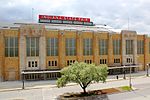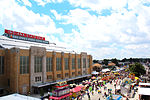Tee Pee Restaurant
Tee Pee Restaurant was a drive-in restaurant in Indianapolis, Indiana, that began business in 1932. In 1939, the original building on Fall Creek Boulevard (now Parkway) was replaced with one having a central stuccoed teepee-shaped section with identical flanking wings. A cantilevered canopy extended around the building. Additions were made to the wings in 1952.: 2 A second restaurant was opened in 1954 on the southside of the city, and a third one in 1964 on the far northside. All three closed (in reverse order of their openings) and were subsequently demolished at different times between 1968 and 1988. The building on Fall Creek was listed on the National Register of Historic Places (NRHP) in 1986 and delisted in 1989.
Excerpt from the Wikipedia article Tee Pee Restaurant (License: CC BY-SA 3.0, Authors).Tee Pee Restaurant
East Fall Creek Parkway North Drive, Indianapolis
Geographical coordinates (GPS) Address Nearby Places Show on map
Geographical coordinates (GPS)
| Latitude | Longitude |
|---|---|
| N 39.825833333333 ° | E -86.131666666667 ° |
Address
East Fall Creek Parkway North Drive
46205 Indianapolis
Indiana, United States
Open on Google Maps






